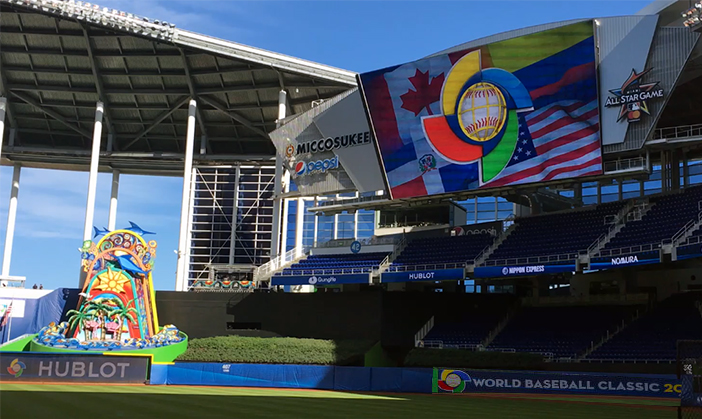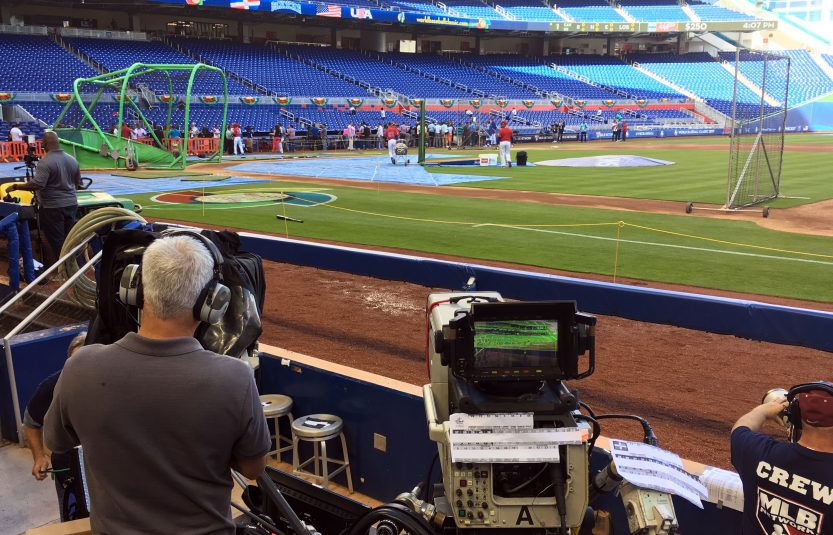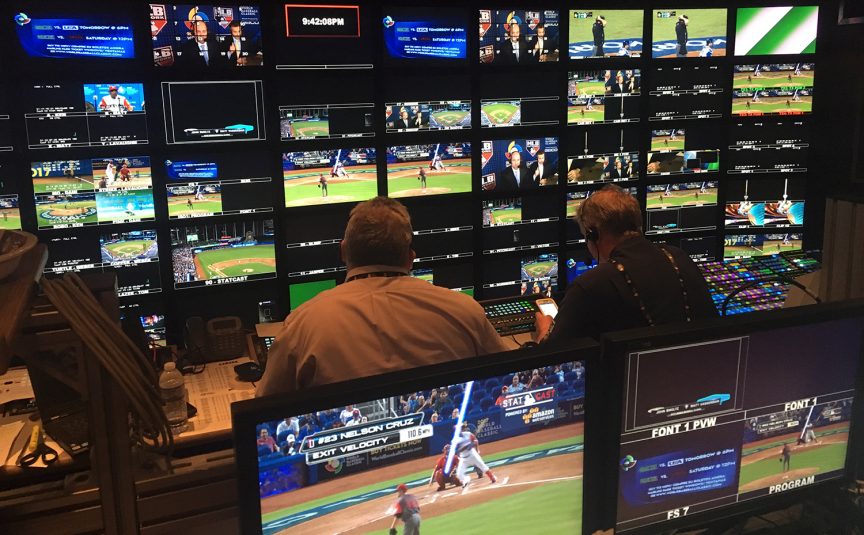At World Baseball Classic, MLB Network Moves Domestic, World Feeds Under Single High-Tech Umbrella
MLBN rolls out EVS XPlore, house-powered UPS, Sony HDC-4800 cam, new Statcast metrics; dedicates WBC effort to the memory of Russ Gabay
Story Highlights
Every four years, the World Baseball Classic provides MLB Network the opportunity to showcase its latest technology and production tools. The quadrennial tradition continues this month, and MLB Network once again serves as the exclusive English-language U.S.-rights holder for the entire WBC. Although it’s MLBN’s third WBC production, it is the first in which the network is overseeing both domestic and world feeds, spurring use of new synergistic production workflows and technologies.
“There aren’t that many events like this where we have exclusive rights, so this is such a fantastic opportunity for us to showcase our production values and technology, as well as shine a light on baseball and the passion for the game that these players have,” MLB Network SVP of Operations and Engineering Susan Stone said Thursday at Miami’s Marlins Park, which is hosting Pool C of the first round. “An event like this brings together every single person at the network — whether it’s production, operations, engineering, marketing, media management.”
‘One Baseball’: Two Feeds Share Resources
MLBN is unifying the domestic- and world-feed productions for all U.S.-based productions in Miami (first round), San Diego (second round), and Los Angeles (semis and finals). At all three venues, the trucks for the two feeds are fully integrated, sharing transmission paths, comms, cameras, dual tally, and the EVS network.
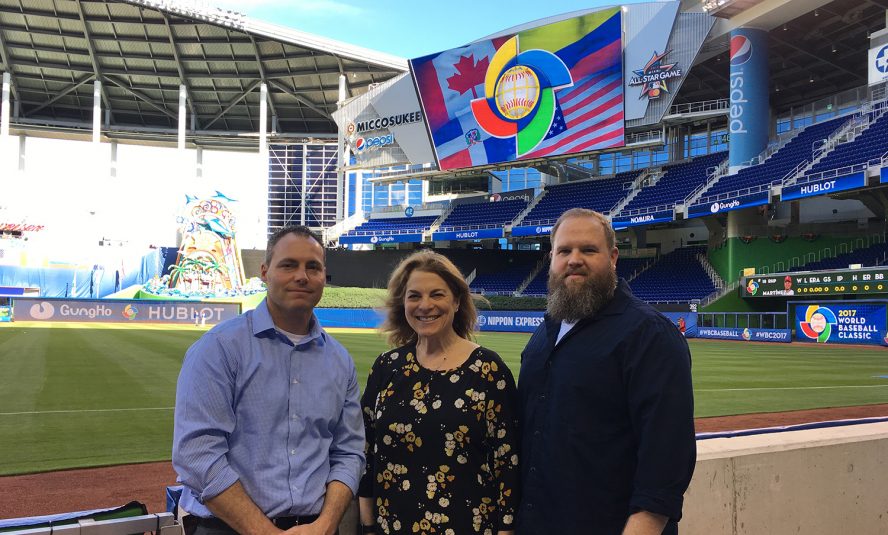
MLB Network’s operations leaders at Marlins Park: (from left) Tom Guidice, Susan Stone, and Jason Hedgcock
“The world-feed truck is producing its own feed and has some of its own cameras, but it has all the resources from the domestic show at its disposal since the two trucks are fully integrated,” said Jason Hedgcock, senior manager, remote technical operations, MLB Network. “We are just trying to utilize the resources as efficiently as possible. It doesn’t make sense operationally if we put a camera out and that camera is not available to the other [production]. We’re together, and we’re all doing the same show, so let’s make things as available as possible.”
MLBN VP, Remote Operations, Tom Guidice noted that the network was also able to reduce the number of cameras deployed without sacrificing angles for either production. “In years past, we put out eight or nine cameras of their own [for world feed], but we’ve reduced that number this year because of how we’re sharing and working together, which is great.”
Integrating the domestic and world feeds has allowed MLB Network to erect a unified EVS network across the two productions. Using EVS Xplore web-browsing interface and XSquare file exchange, both trucks can push and pull content from the MLBN’s Secaucus, NJ, production facility without needing to access the content through the cloud. When a third production — the onsite studio show — is added in Los Angeles, that truck will also have access to the network.
“We have connectivity with all of our edit bays in New Jersey to recut highlights between games and push and pull [content] from New Jersey to all the trucks,” said Hedgcock. “It allows us to share resources, so we’re not taking up multiple drive spaces in the world-feed truck or the domestic truck. Content is stored on one server, and we play it in either truck. It allows us to expand without additional cost. We can add one six-channel EVS [replay server], and you access it for both trucks, so you can start to utilize your space much more efficiently.”
In addition, technical- and production-management teams for each feed have had common meetings throughout the lead-up to the event.
“There are amazing synergies and economies of scale created by having us produce both the domestic and the world feed this year,” said Stone. “From a production perspective, [Senior Coordinating Producer, Live Events,] Chris Pfeiffer has done a fantastic job unifying how everything looks across every single game: viewers who are watching the world feed in Amsterdam are getting the same quality and type of production as the viewer who is watching it in Philadelphia.”
All Roads Lead to L.A.: Ramping Up Cameras, Audio, Statcast
All first- and second-round pool-play games in the U.S. will have similar equipment levels and camera complements. The semis and final in L.A. (March 20-22) will add a few key cameras, expand the on-field audio coverage, and roll out the same onsite studio set used at All-Star events and the World Series for pre/postgame coverage.
MLBN’s Miami and San Diego productions feature about 20 cameras, including an RF handheld (from CP Communications), two Phantom ultra-slo-mos (from Inertia Unlimited), a Sony HDC-4300 8X ultra-slo-mo, four robos (from Fletcher Sports), and a blimp. In Los Angeles, the production will add a roving RF camera on a MōVI three-axis gimbal to provide dramatic tracking shots. In addition, MLBN will replace the HDC-4300 with a Sony HDC-4800 4K 8X slo-mo camera (in conjunction with a PWS-4500 production-server) that enables HD cutout from the 4K image and Super Zoom.
“We are trying to keep the same camera count throughout the whole tournament domestically, so our director John Moore and the production team can have the same tools every single round,” Guidice explained. “That way, they can get into a really good rhythm and utilize everything to its max.”
In addition, the world feed has six unilateral cameras at all games: five hard and one handheld.
On the audio side, all games will have miked-up bases and infield mics. The L.A. games will have eight mics buried throughout the infield, mics on all three bases, five parabolas (three static and two manned), and 28 mics along the outfield wall.
The latest metrics available from MLBAM’s Statcast player-tracking system will be featured. The new Catch Probability and Hit Probability will be part of Statcast for the 2017 season but will make their debut during the WBC.
Inside the Compounds: Game Creek Paves the Way
Game Creek Video is providing the facilities in all three cities. In Miami, Victory A and B are working the domestic show; Maverick and Edit 3, the latter making its debut, are handling the world feed. Those trucks will then work the L.A. games, along with Larkspur and Edit 2, which will handle the added onsite studio show at Dodger Stadium (and also share the EVS network).
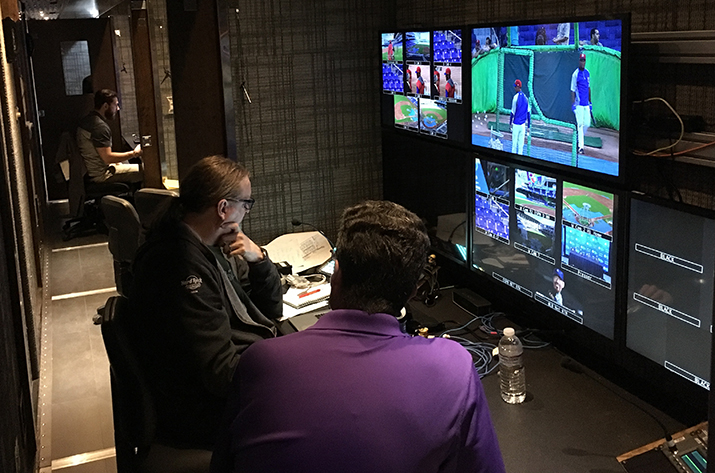
Game Creek’s new Edit 3 truck, with an ultra-flexible layout, debuts for MLBN at the WBC and will be a regular on MLB Network Showcase productions this season.
“Edit 3 is the new truck that was built for our [MLB Network] Showcase, but it’s [debuting] here,” said Stone. “The great other thing about [WBC] is that it gives us a chance to install more of our equipment [in advance], use it here, but be more prepared for our first Showcase on April 4.”
MLBN will deploy Game Creek Pride and Glory (NFL Network’s fully integrated trucks, coming right off the NFL combine) in San Diego.
Edit 3 isn’t the only new face in the compound. MLBN is using a Saunders Electric UPS system for the first time ever at all three WBC U.S. venues. The UPS system is fed by house power (backed up by a generator in case of power loss), which means that MLBN does not have to burn any diesel fuel. In the case of the production in Miami, MLBN and Saunders are eliminating roughly 230 hours of generator runtime, saving about 3,450 gallons of diesel fuel.
Should stadium power fail, the system will automatically trigger the backup generator within 18 seconds (battery power lasting up to 20 minutes can power the compound). Saunders’s UPS systems have been used extensively on live entertainment productions like the Emmys and Oscars, and MLBN has used it as part of its NHL coverage, but this marks its baseball debut.
“One thing that is on every broadcaster’s mind is how we’re doing power,” noted Hedgcock. “This has been great for us here so far. In fact, it already proved its worth: the house took a power hit [on Wednesday], and no one in the compound knew because we had the failover generator. The only reason we knew is, the emergency lights and alarm in the ballpark came on, but the compound was unaffected.”
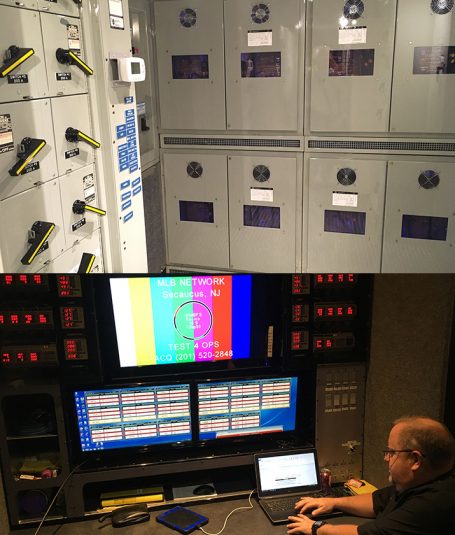
For WBC, a Saunders Electric UPS system (top), running on house power, is deployed for baseball for the first time. The system features an extensive control and monitoring system.
Around the Globe and in Secaucus
Of course, MLBN’s WBC coverage goes well beyond just the games taking place in the States. The production team is also in charge of the world feed and domestic U.S. telecast for all international games in Seoul, Tokyo (Pool B), and Jalisco, Mexico. MLBN is working with local broadcasters (JTBC in Korea, NHK in Japan, Televisa in Mexico), relying on a mix of local crew and deploying members of its own production, operations, and technical teams to each location.
Tech Managers Larry Meyer, Takashi Tajima, Gabe Nucci, Mike Muniz, Debra Zouvas, Ed Ryan, Zaac Christopher, Jon Hazell, and Matt Benedict have deployed to different cities to oversee various world and domestic feeds and will converge in L.A. — where it’s all-hands-on-deck.
In Secaucus, MLBN has converted its PC1 control room into WBC Master Control to handle the large number of games being broadcast over the next two weeks.
Russell Gabay: Gone, But Certainly Not Forgotten
This year’s WBC will be produced without someone who helped elevate the production over the years: Russ Gabay, who died in November. As MLB VP and executive producer of international broadcasting for two decades, he was integral in laying the foundation for the World Baseball Classic and is very much in the hearts and minds of the entire MLB crew during this year’s event.
“The team that he put together since 2006 [wants] to dedicate this 2017 World Baseball Classic to him and keep his spirit alive,” said Guidice. “His fingerprints are on this entire tournament and absolutely everything we do here.”
